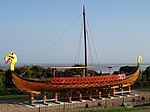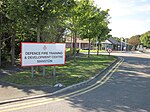Cliffsend

Cliffsend is a village (sometimes written, correctly, as Cliffs End) and civil parish situated almost 2 miles (3 km) west of Ramsgate, Kent, United Kingdom, in the Thanet local government district. Hengist and Horsa landed near here in 410AD, and St Augustine in 597. There is evidence to show that the area of Cliffsend Village was inhabited since ancient times. Excavations prior to a housing development at Cliffs End Farm in 2003/2004 revealed artefacts and a burial site dating to the Bronze Age. Pegwell Bay Country Park is located here. Also on permanent display on the cliff top at Pegwell Bay is a replica of the Viking longship Hugin, which sailed from Denmark to Thanet in 1949 to celebrate the 1500th anniversary of the invasion of Britain, the traditional landing of the two men, and the betrothal of Hengist's daughter, Rowena, to King Vortigen of Kent. The Hugin was offered as a gift to Ramsgate and Broadstairs by the Daily Mail for preservation.
Excerpt from the Wikipedia article Cliffsend (License: CC BY-SA 3.0, Authors, Images).Cliffsend
Foads Lane, Thanet Cliffsend
Geographical coordinates (GPS) Address Nearby Places Show on map
Geographical coordinates (GPS)
| Latitude | Longitude |
|---|---|
| N 51.32897 ° | E 1.36591 ° |
Address
Foads Lane
CT12 5JH Thanet, Cliffsend
England, United Kingdom
Open on Google Maps








